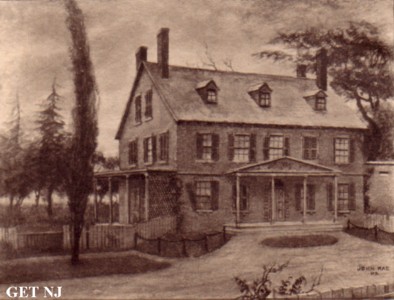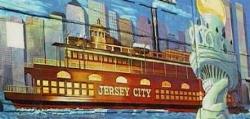 |  |  |
|
| ||
 |  |  |
 |  |  |
|
| ||
 |  |  |
|
|
|
Historic Houses
Burlington
From Historic Houses of New Jersey by W. Jay Mills, 1902
ON OTHER large Quaker settlement in Southern Jersey is the old city of Burlington. Unlike Haddonfield, Burlington has not changed very much in the last hundred years, and still retains an eighteenth-century air. On its broad streets are many decaying mansions
historic associations would fill a goodsized volume. There is the house occupied by Governor William Franklin during the happiest years of his governorship, and where he returned at the last a prisoner of the colonists. A short distance away is the dwelling where Captain James Lawrence, the naval hero, was born, and Jonathan Odell often came to sup during his pastorate in the city. There is another smaller house in the town where the former passed some of his early youth, and close by is a sister-house where his little playfellow James Fenimore Cooper lived. Buildings linked with our early history greet us at every street corner. A few of the " fair and great brick houses" Gabriel Thomas saw in the Burlington of 1697 still remain, but they are now of very dilapidated and sad appearance. Overlooking the quiet Delaware is one of the most interesting of all the houses in the town, the Bradford Mansion, the one-time home of quaint Mrs. William Bradford, born Susan Vergerau Boudinot.
|
 |
Generations of children loved and feared the great blue Chinese porcelain lions which guarded the well-kept lawn. They were a very original garden decoration and used to be one of the sights of old Burlington. The boys of the Friends' School delighted to romp on the lawn, for they were pretty sure of the excitement of a chase by Ambrose, the colored butler and the autocrat of the kitchen. Life in that old-time dwelling was very different from that we know to-day. Miss Jane J. Boudinot, in her charming reminiscences of Mrs. Bradford, writes:
A picturesque figure in Mrs. Bradford's household who should not be forgotten was the little governess. She was a French refugee from St. Domingo, and had come there first during Elias Boudinot's lifetime, as an amanuensis. The home offered her was a haven of refuge, and she lingered on long after her master, and grew old in the service of his grandnieces and grandnephews. Like all French refugees from the West Indies, she had a romance, her lover having been shot dead before her eyes. She was very kind to the children, and loved to give them sweetmeats and bonbons. Her English was very grotesque, and Miss Boudinot relates it was only outdone by that of Ambrose, the African butler. "He" with that worthy was always "she," and "she" "he." When announcing the daily visits of Bishop Doane to his aged parishioner, he would invariably say, "De bitchip man. Shall she walk up?"
Burlington before the War of 1812 was quite a summer resort for the fashionables of Philadelphia. The Binneys, Whartons, Shippens, Chaunceys, Mcllvains, and many other noted families had country-seats there, and social intercourse was frequent. For a long period of years after her young husband's death, Mrs. Bradford seldom appeared in society. All through her long life she was ever faithful to his memory. Elias Boudinot, her father, was fond of entertaining the friends of his youth, and the Washingtons, Laurenses, Rutledges, Daytons, Bayards, and Ogdens are among the distinguished families sheltered at one time or another by its ancient roof. In the library of the Bradford Mansion this grand old man of America wrote his famous "Star of the West." He was past seventy years of age then, but still looked as he did in his excellent portrait painted by Sully, the favorite artist of old Philadelphia society. All through her life Mrs. Bradford proudly displayed to admiring friends many historic keepsakes. One of these was a small cushion made from Mrs. Washington's brocade wedding-dress. Another was a pair of bracelets containing the hair of General Washington. At her death she left many of her treasures in her will to friends, but by far the greater number of them are now in the possession of Miss J. J. Boudinot, of New Jersey.
The Bradford Mansion of to-day is very different from the house Mrs. Bradford knew. Its wide rooms have been separated for two establishments, and it has been much desecrated. The sweeping lawn leading to it has been cut up, and time and the hand of man have felled some of the aged trees which guarded it like a corps of faithful sentinels. It is sad to think that it should have passed out of the possession of the family which made it celebrated, but that is the fate of most old houses. They are doomed to linger on in poverty and neglect long after their original owners are sleeping. In poverty, because they must starve in their old age for the sound of familiar voices they once knew and loved, and in neglect because new owners rarely come to them unless forced to. Each has its memories and traditions, - perhaps a few bright flowers grown among many, many tears.
The old Bradford Mansion should have fallen when its quaint little mistress died. They were of another period, but their pictures still live in the minds of many, - a lady in a sedan chair, and a home of the old regime.
 Your Ancestors' Story |
 Bruce Springsteen's Jersey Shore Rock Haven! |

|
UrbanTimes.com |